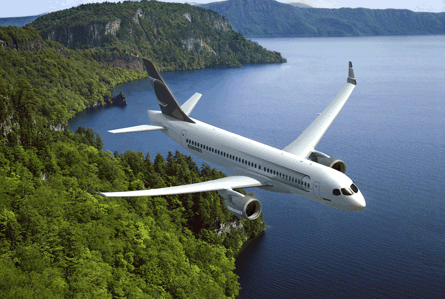Celebrations by Airbus over securing Virgin America as the launch customer for the A320neo and a pledge by Indian carrier IndiGo for 150 of the aircraft are underpinned by uncertainty over where these developments leave Bombardier's CSeries. The key questions are how, and if, Bombardier's CSeries clean sheet design really competes with Airbus's re-engined offering.
Virgin America's admission that it considered the CSeries begs a pertinent question of whether carriers are simply using the aircraft as leverage with Airbus, and to an extent, Boeing, to persuade the big two airframers to deliver significant gains in fuel efficiency during the next few years.
Airbus is pledging up to a 15% fuel burn improvement on the A320neo, while the CSeries, powered by the Pratt & Whitney PW1500G geared turbofan, promises 20% less fuel consumption versus current aircraft models.
 |
|---|
© Airbus |
 |
© BombardierVirgin America considered the Bombardier CSeries (bottom) before choosing the Airbus A320neo (above) |
The CSeries certainly put Airbus on the defensive almost a year ago, before the A320neo's launch, after Frontier Airlines' parent Republic Airways Holdings ordered 40 of the 138-seat CS300 aircraft. Adam Pilarski, senior vice-president of consultancy Avitas, declared the contest a "real competition" with Bombardier competing fairly and Airbus ultimately losing to the Canadian manufacturer. Before the ownership change, Frontier was historically an all-Airbus operator.
But CSeries orders have dried up since Republic's watershed deal in February 2010, and some analysts are concerned the A320neo could edge the CSeries in other competitive bids. Citing comments by Virgin America that the CSeries was the most likely alternative, Raymond James Canadian analyst Steve Hansen believes that is a "marginal endorsement, but second place doesn't translate into orders".
Raymond James downgraded Bombardier, and its analysts "are increasingly mindful of the [A320]neo's rapid adoption and the potential impact on the CSeries business case".
But declarations that the A320neo is the death knell for the CSeries are likely to be premature as Virgin America and IndiGo are existing Airbus customers. At the same time, Virgin America chief executive David Cush explained that the carrier examined the CSeries, but stressed that it was a committed customer of Airbus. Once Airbus decided to re-engine the A320, the answer was clear. The airframe has 95% commonality with the current A320 model, of which Virgin America has only 35, and pilots need to complete a mere 3h of software training to fly the A320neo.
Bank of America Merrill Lynch analyst Ron Epstein does not see "a connection between Virgin America and the CSeries". In fact, Epstein envisages the CSeries and the A320neo co-existing on a fleet plan driven less on commonality. Nothing dictates that the CSeries and the A320neo are mutually exclusive, he says. Epstein easily foresees a split buy between a smaller CS100 or CS300 paired with an A319neo or A320neo.
Citing the roughly 20-seat differential between the larger CS300 and the A320neo, RBC Capital Markets analyst Walter Spracklin says the equivalent CSeries competitor is the A319neo, which is not expected to be available until six months or a year after the A320neo's debut.
The 2013 service entry of the CSeries versus an emergence of the A319neo around 2017 gives Bombardier a key window of opportunity to compete against Airbus, says Spracklin.
















